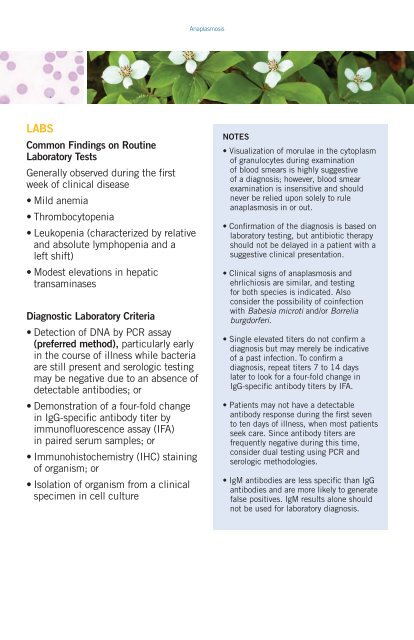tick-borne-dx-physician
tick-borne-dx-physician
tick-borne-dx-physician
Create successful ePaper yourself
Turn your PDF publications into a flip-book with our unique Google optimized e-Paper software.
Anaplasmosis<br />
LABS<br />
Common Findings on Routine<br />
Laboratory Tests<br />
Generally observed during the first<br />
week of clinical disease<br />
• Mild anemia<br />
• Thrombocytopenia<br />
• Leukopenia (characterized by relative<br />
and absolute lymphopenia and a<br />
left shift)<br />
• Modest elevations in hepatic<br />
transaminases<br />
Diagnostic Laboratory Criteria<br />
• Detection of DNA by PCR assay<br />
(preferred method), particularly early<br />
in the course of illness while bacteria<br />
are still present and serologic testing<br />
may be negative due to an absence of<br />
detectable antibodies; or<br />
• Demonstration of a four-fold change<br />
in IgG-specific antibody titer by<br />
immunofluorescence assay (IFA)<br />
in paired serum samples; or<br />
• Immunohistochemistry (IHC) staining<br />
of organism; or<br />
• Isolation of organism from a clinical<br />
specimen in cell culture<br />
NOTES<br />
• Visualization of morulae in the cytoplasm<br />
of granulocytes during examination<br />
of blood smears is highly suggestive<br />
of a diagnosis; however, blood smear<br />
examination is insensitive and should<br />
never be relied upon solely to rule<br />
anaplasmosis in or out.<br />
• Confirmation of the diagnosis is based on<br />
laboratory testing, but antibiotic therapy<br />
should not be delayed in a patient with a<br />
suggestive clinical presentation.<br />
• Clinical signs of anaplasmosis and<br />
ehrlichiosis are similar, and testing<br />
for both species is indicated. Also<br />
consider the possibility of coinfection<br />
with Babesia microti and/or Borrelia<br />
burgdorferi.<br />
• Single elevated titers do not confirm a<br />
diagnosis but may merely be indicative<br />
of a past infection. To confirm a<br />
diagnosis, repeat titers 7 to 14 days<br />
later to look for a four-fold change in<br />
IgG-specific antibody titers by IFA.<br />
• Patients may not have a detectable<br />
antibody response during the first seven<br />
to ten days of illness, when most patients<br />
seek care. Since antibody titers are<br />
frequently negative during this time,<br />
consider dual testing using PCR and<br />
serologic methodologies.<br />
• IgM antibodies are less specific than IgG<br />
antibodies and are more likely to generate<br />
false positives. IgM results alone should<br />
not be used for laboratory diagnosis.



